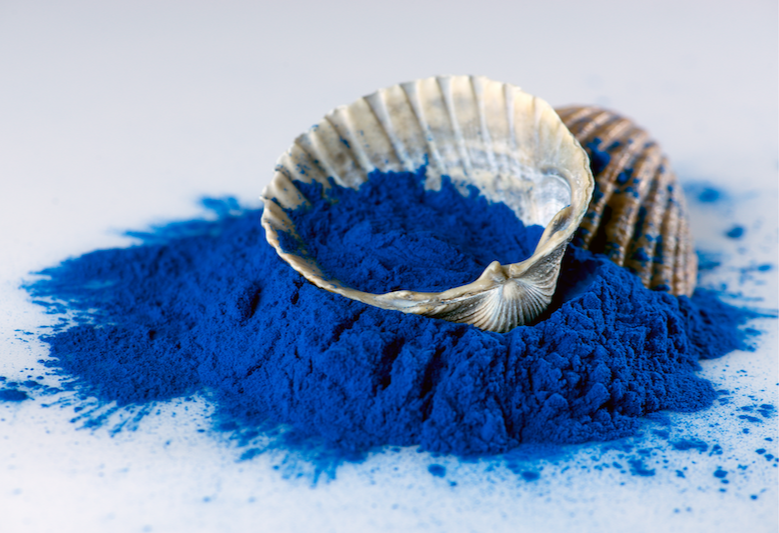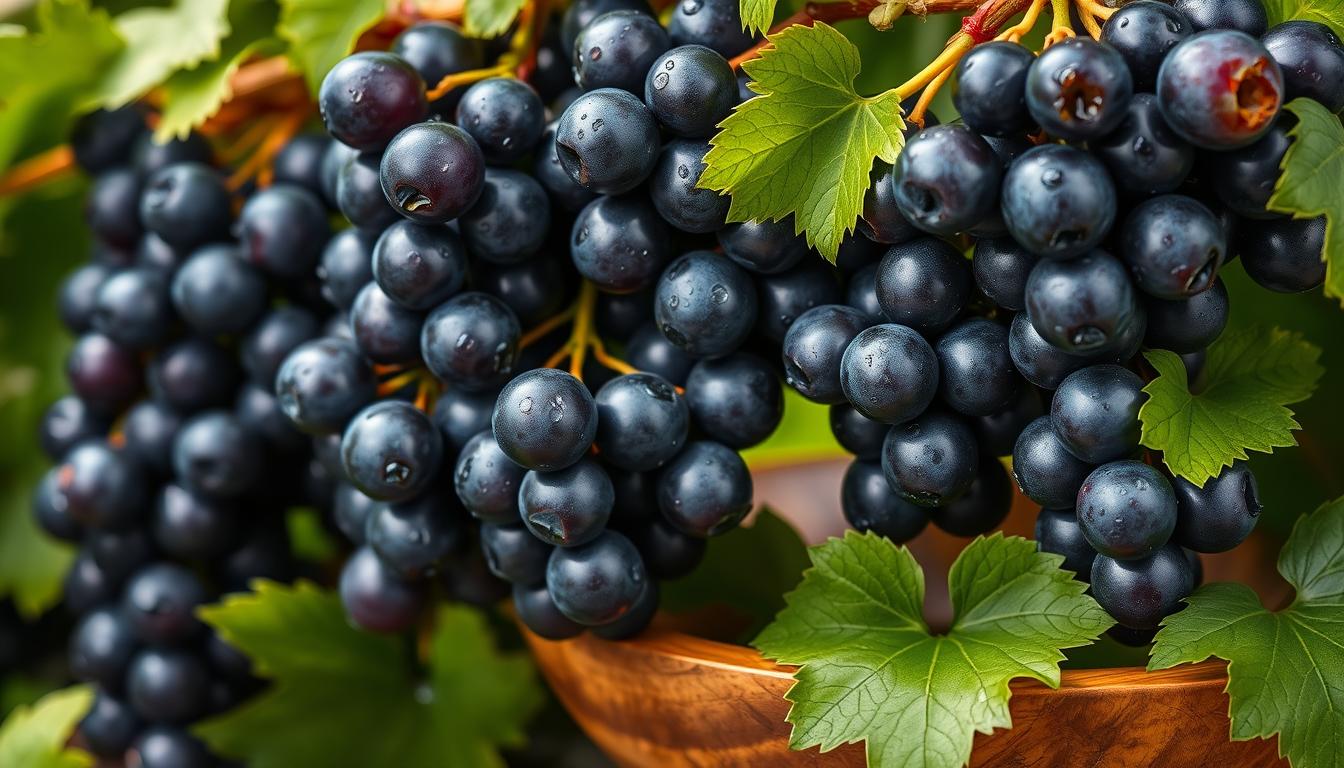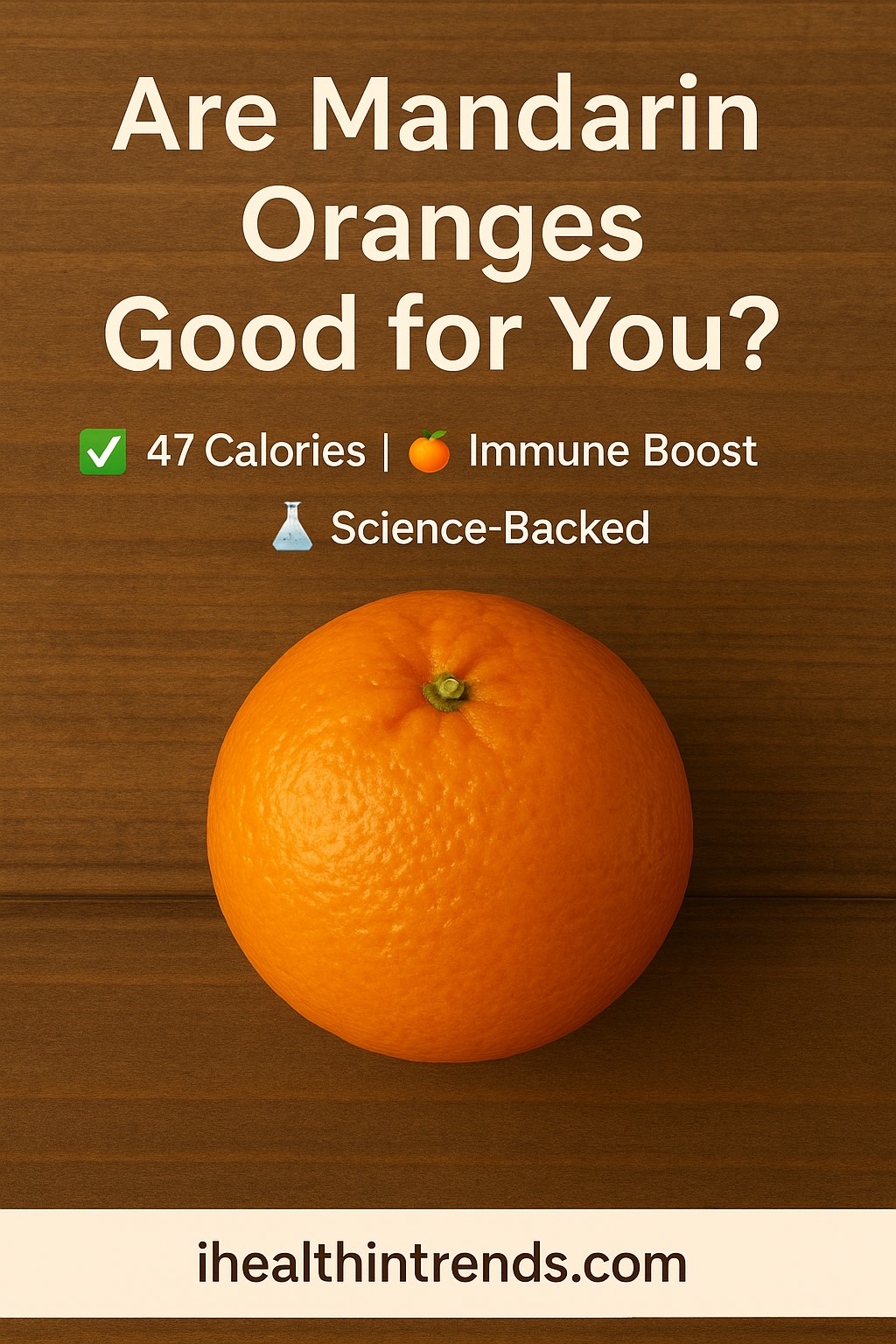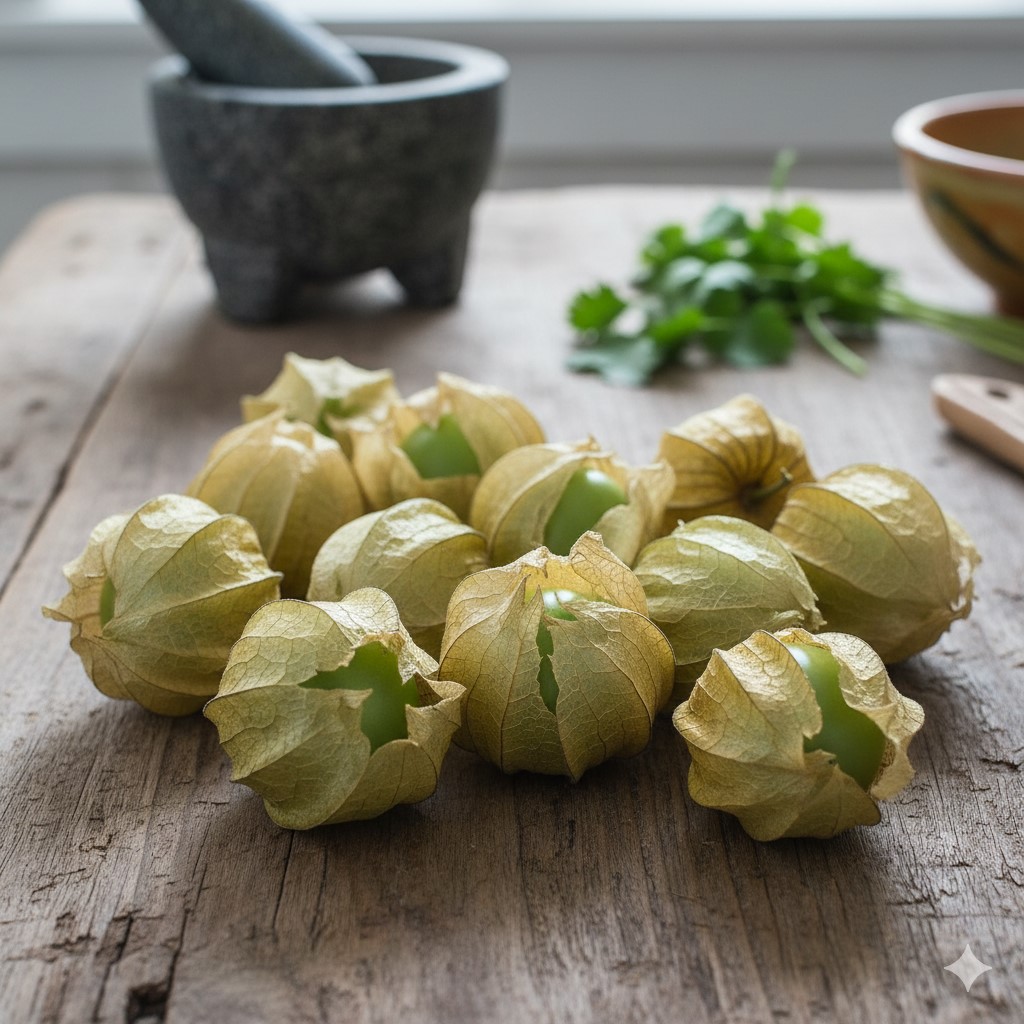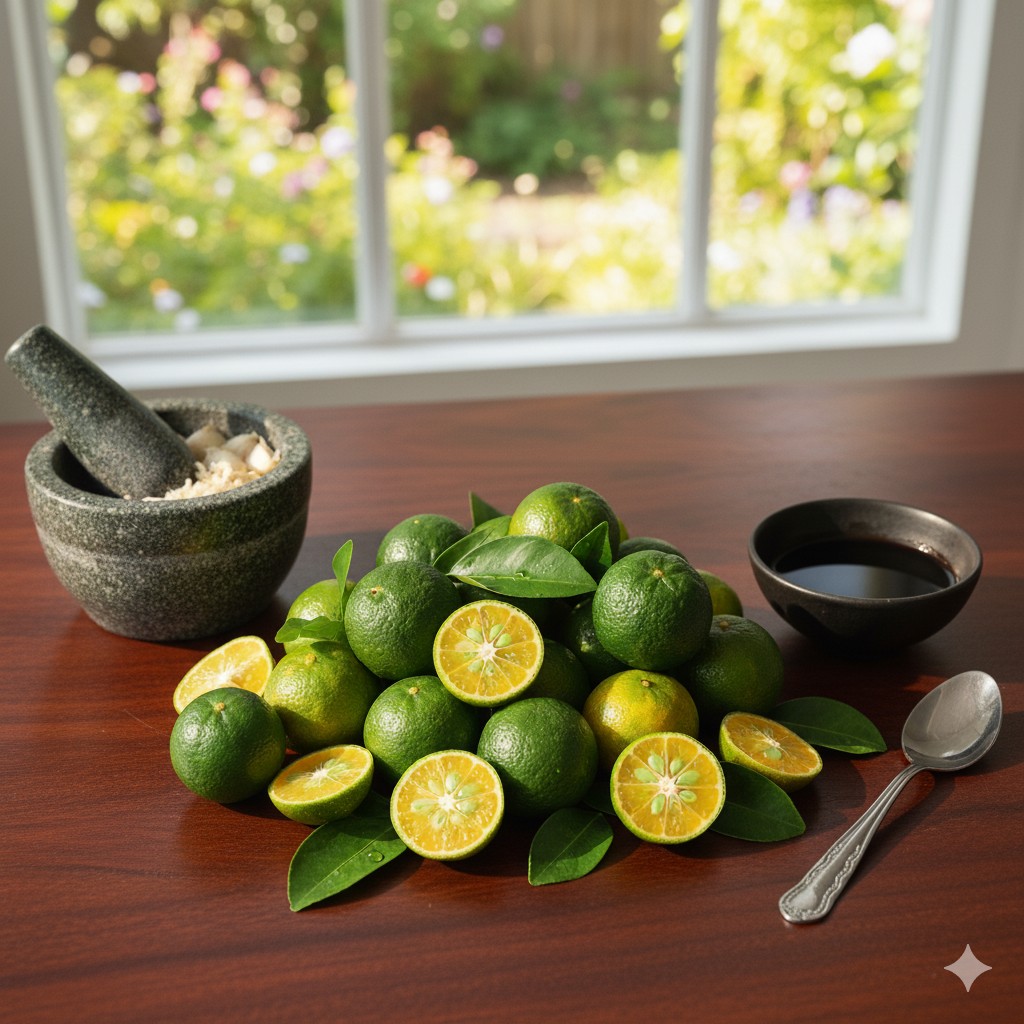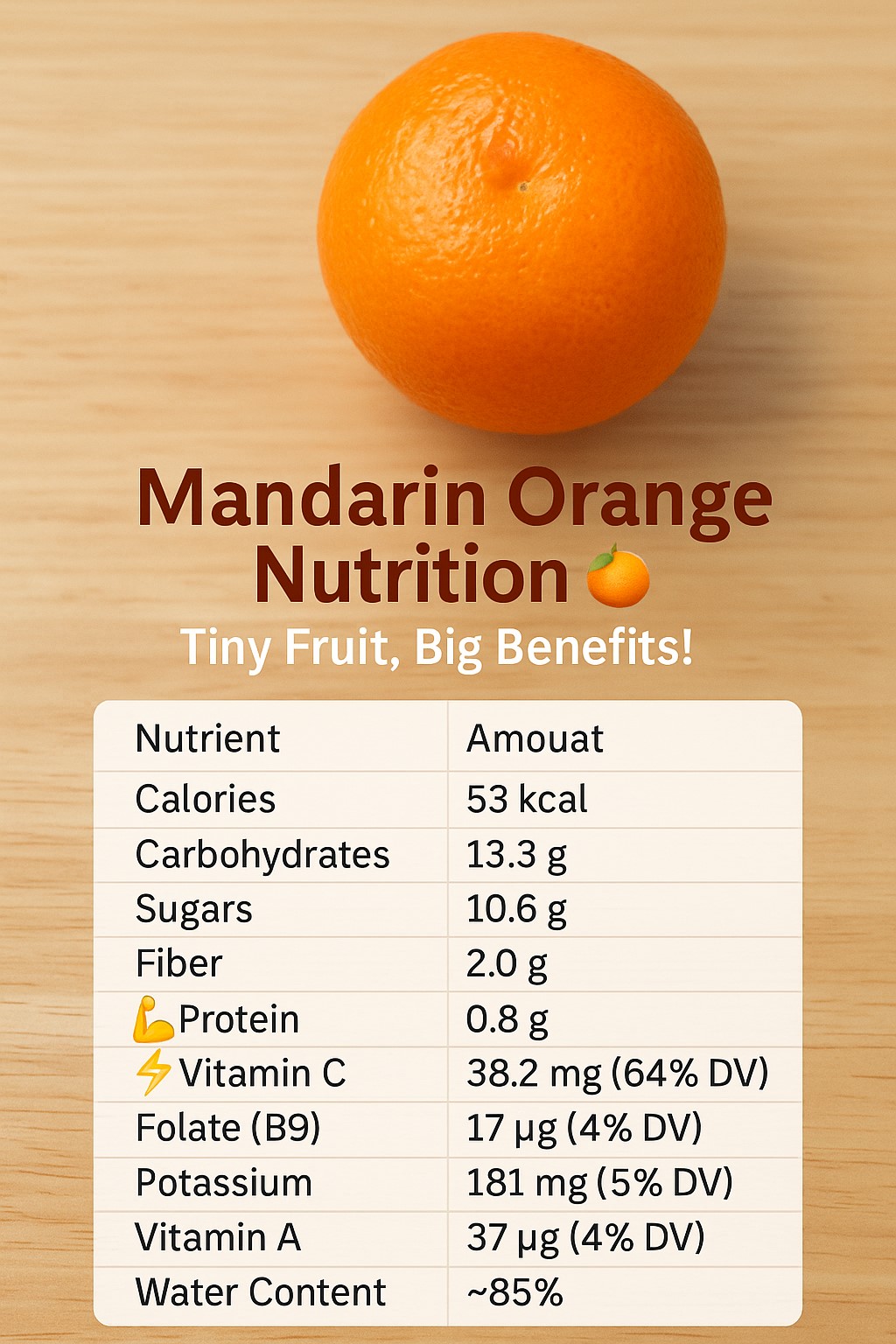Langsat or lanzones? Duku or fruit langsat? Discover what this tropical fruit really is, how it tastes, where it grows, and where to buy it in the U.S. and Philippines. Your complete, science-backed guide.
The Garlic-Looking Fruit That Tastes Like Sunshine
If you’ve ever seen a cluster of small, golden-brown fruits that suspiciously resemble garlic bulbs, but smell sweet and floral congratulations! You’ve met langsat (also known as lanzones in the Philippines).
This tropical gem is beloved across Southeast Asia—but remains a mystery to many in the U.S. and even some parts of the world.
In this definitive guide, you’ll learn:
✅ What langsat really is (and why it has so many names)
🌍 Where it grows—and when it’s in season
👅 What it tastes like (with flavor comparisons)
➡️ Its science-backed nutritional benefits
🛒 Where to buy fresh or canned langsat in the U.S. and Philippines
🌳 How it differs from duku, longan, and other look-alikes
Whether you’re a curious foodie, a Filipino abroad missing home-seasonal fruit, or a gardener dreaming of tropical trees—this guide is your one-stop resource.
What Is Langsat? Botanical Identity & Common Names
- Scientific Name: Lansium domesticum
- Family: Meliaceae (the same family as mahogany trees!)
Langsat is a tropical fruit tree native to the Malay Archipelago, including parts of Malaysia, Indonesia, the Philippines, and southern Thailand. It thrives in hot, humid, lowland rainforest climates.
Why So Many Names?
The confusion around “langsat vs lanzones vs duku” stems from regional naming, not botanical. Lansium domesticum goes by different names across Southeast Asia, often reflecting local varieties or cultural preferences. Here’s the breakdown:
- 🇵🇭 Philippines: Lanzones
- The most common name nationwide.
- Celebrated in festivals like the famous Lanzones Festival in Camiguin every October.
- 🇲🇾 Malaysia & 🇮🇩 Indonesia:
- Langsat: Thin-skinned, slightly tart, often with 1–2 seeds per segment.
- Duku: Thicker skin, sweeter flesh, sometimes nearly seedless.
- Both are considered cultivars (varieties) of the same species: Lansium domesticum.
- 🇹🇭 Thailand: Longkong
- A premium, seedless type of duku, grown mainly in southern provinces like Krabi and Surat Thani.
- Known for its intense sweetness and easy-to-peel skin.
- International / Scientific Use: Langsat
- Used by the FAO, USDA, and botanical databases as the standard English name.
- “Lanzones” is widely understood (especially in Filipino communities) but appears less frequently in scientific literature.
Key Insight:
Think of Lansium domesticum as a species with cultivars—like how “apple” includes Fuji, Gala, and Granny Smith.
- Langsat: Thin skin, often slightly tart, 1–2 seeds per segment
- Duku/Lanzones: Thicker skin, sweeter, sometimes seedless
Bottom Line: They’re not different fruits—just regional expressions of the same species.
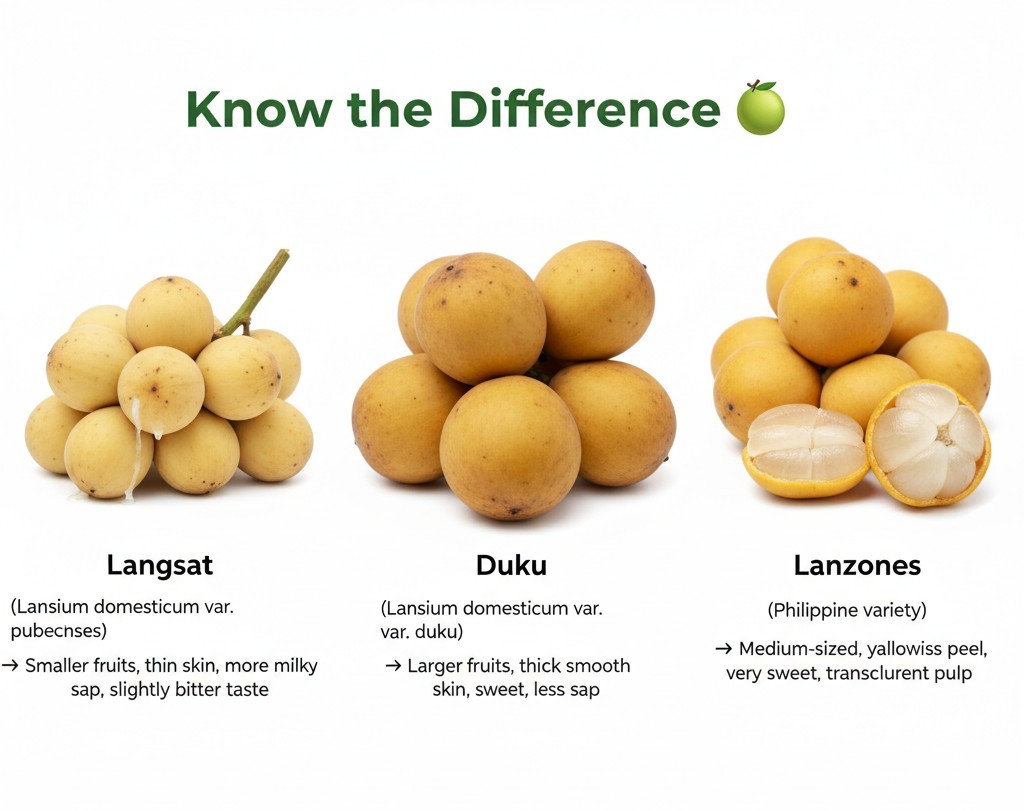
by comparing their color, size, and skin texture.
Appearance: How to Recognize Langsat
Langsat grows in grape-like clusters of 5–30 fruits. Each fruit is:
- Size: 2–5 cm long (about the size of a large grape or small plum)
- Skin: Smooth, thin to medium-thick, turns golden yellow to light brown when ripe
- Flesh: Translucent white, segmented (like garlic cloves), juicy
- Seeds: 1–3 per segment (bitter—do not eat)
Ripeness Tip:
Ripe langsat yields slightly to gentle pressure and has a sweet, floral aroma. Avoid fruits with dark spots or excessively hard skin.
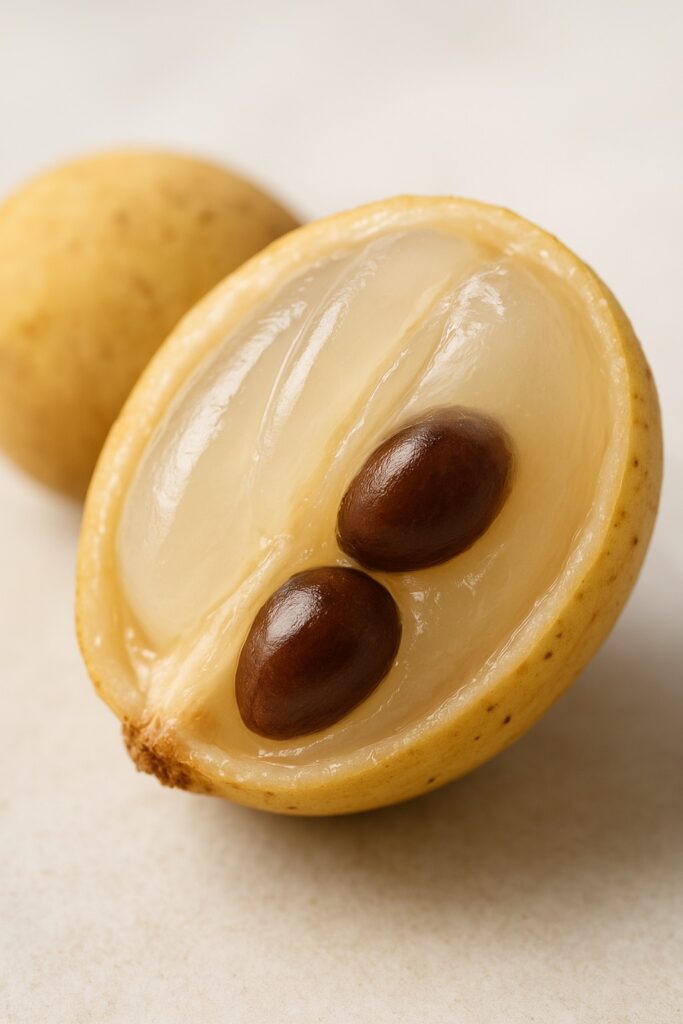
sweet with a hint of tartness
Taste & Texture: What Does Langsat Really Taste Like?
Describing langsat’s flavor is a favorite pastime among Southeast Asians—and for good reason!
- Primary Flavor: Sweet with a bright, citrusy tang (like a mix of grape, grapefruit, and lychee)
- Aftertaste: Clean and refreshing—never cloying
- Texture: Juicy and tender, similar to lychee or rambutan, but less gelatinous.
Common Comparisons:
- “Like a sweet tangerine crossed with a pear”
- “Lychee’s more aromatic cousin”
- “If grapes and calamansi had a baby”
“Like calamansi, langsat is a Southeast Asian fruit rich in vitamin C—but while calamansi delivers a sharp, lime-like tang, langsat offers a balanced sweet-tart juiciness that’s far more delicate.
Pro Tip: Chill langsat before eating—it enhances sweetness and refreshment!
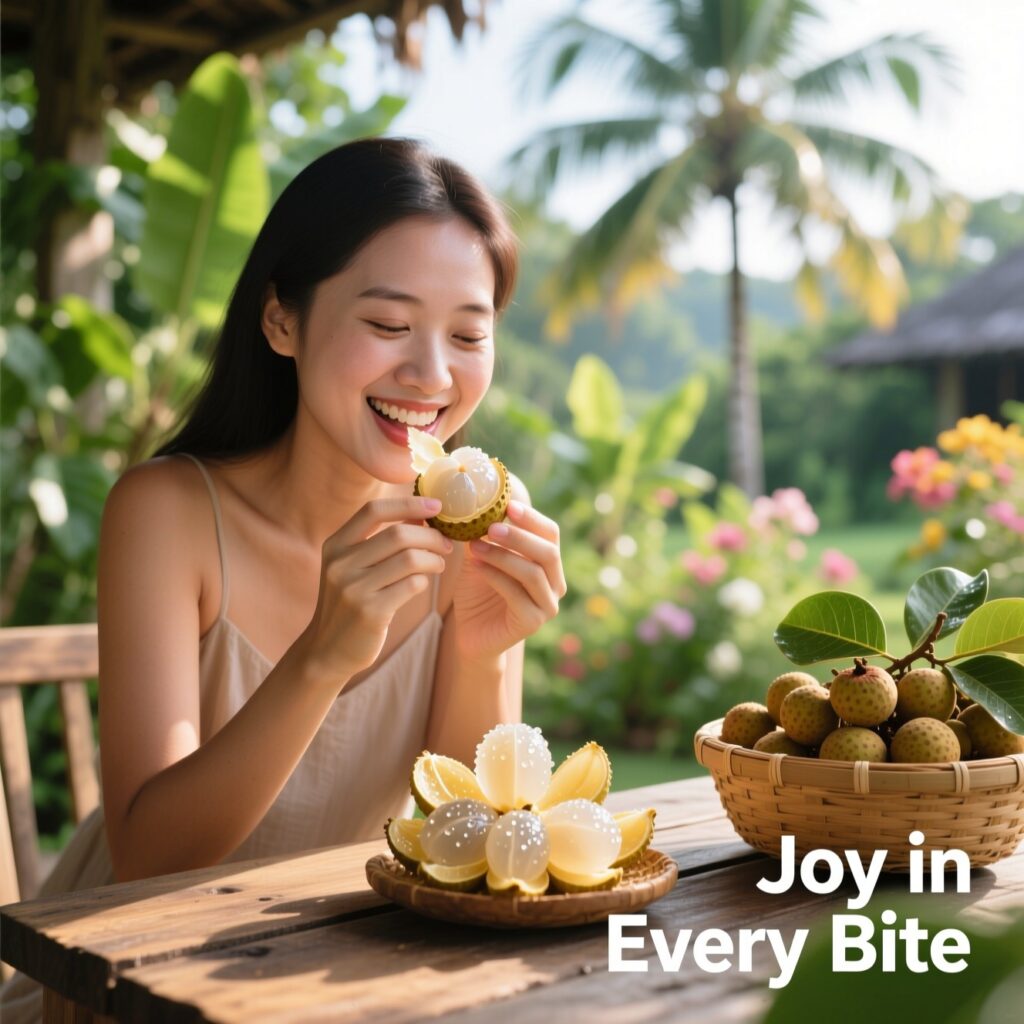
favorite known for its refreshing flavor and juicy pulp.
Origin & Global Cultivation
Langsat is indigenous to western Southeast Asia. Wild varieties still grow in:
- Peninsular Malaysia
- Sumatra and Borneo (Indonesia)
- Southern Philippines (Mindanao, Camiguin, Bohol)
Today, it is cultivated in:
- Philippines → Camiguin Island is the “Lanzones Capital”
- Malaysia → Johor, Pahang
- Indonesia → Java, Kalimantan
- Thailand → Southern provinces
- Limited trials in Hawaii, Puerto Rico, and Florida (USA)—but not commercially grown in the continental U.S.
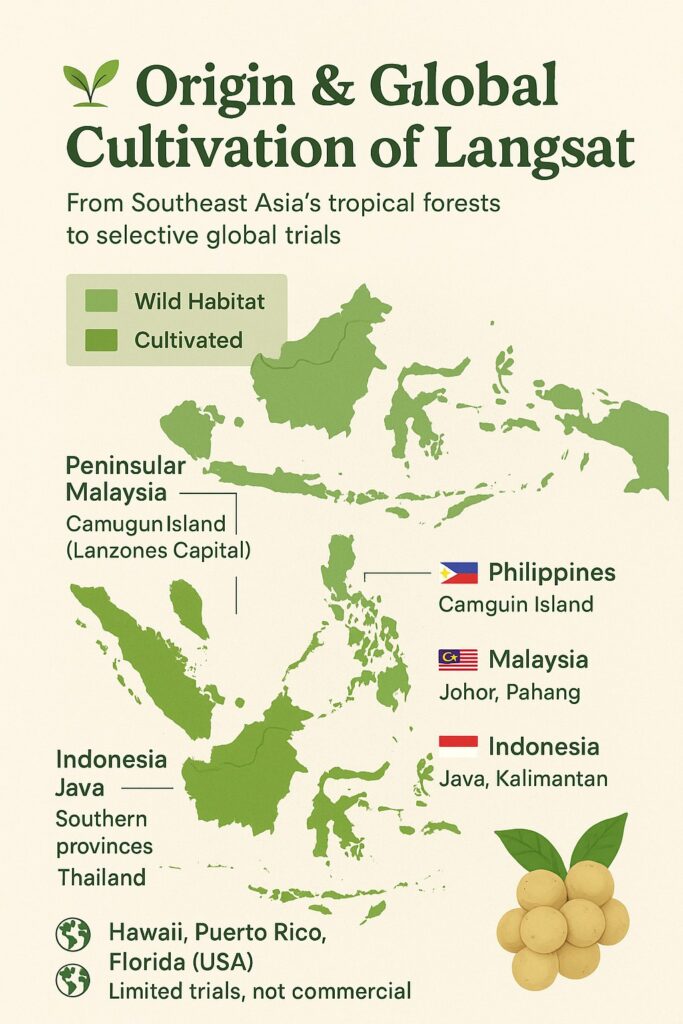
Langsat Season: When Is It Fresh?
Langsat is highly seasonal—you won’t find it year-round.
| COUNTRY | PEAK SEASON |
|---|---|
| Philippines | August to October (Camiguin Festival: 3rd week of October) |
| malaysia | July to September |
| Indonesia | August to November |
| Thailand | June to August (Longkong variety) |
In the U.S.?
Fresh langsat is rare and only available during peak season (Aug–Oct) in select Asian markets (see below). Canned or frozen versions may be found year-round.
Nutritional Profile & Health Benefits
Langsat isn’t just delicious—it’s packed with nutrients. According to the USDA FoodData Central and studies from University of the Philippines Los Baños and Universiti Putra Malaysia:
Per 100g of edible langsat flesh:
- Calories: 70–80
- Vitamin C: ~30 mg (50% of daily value)
- Fiber: 2–3g
- Potassium: 200–250 mg
- Antioxidants: Polyphenols, flavonoids
Langsat contains about 30mg of vitamin C per 100g—similar to a mandarin orange—making it a great natural source of this immune-supporting nutrient.
Potential Benefits (Based on Peer-Reviewed Research):
- Immune Support
High vitamin C content helps maintain immune function (NIH, 2022). - Digestive Health
Dietary fiber aids regularity and gut health (Journal of Food Science, 2020). - Antioxidant Protection
Polyphenols may help combat oxidative stress (Antioxidants Journal, 2021). - Low Glycemic Impact
Natural sugars are balanced with fiber—likely low to medium GI (exact GI not established, but safer than high-sugar fruits for moderate consumption).
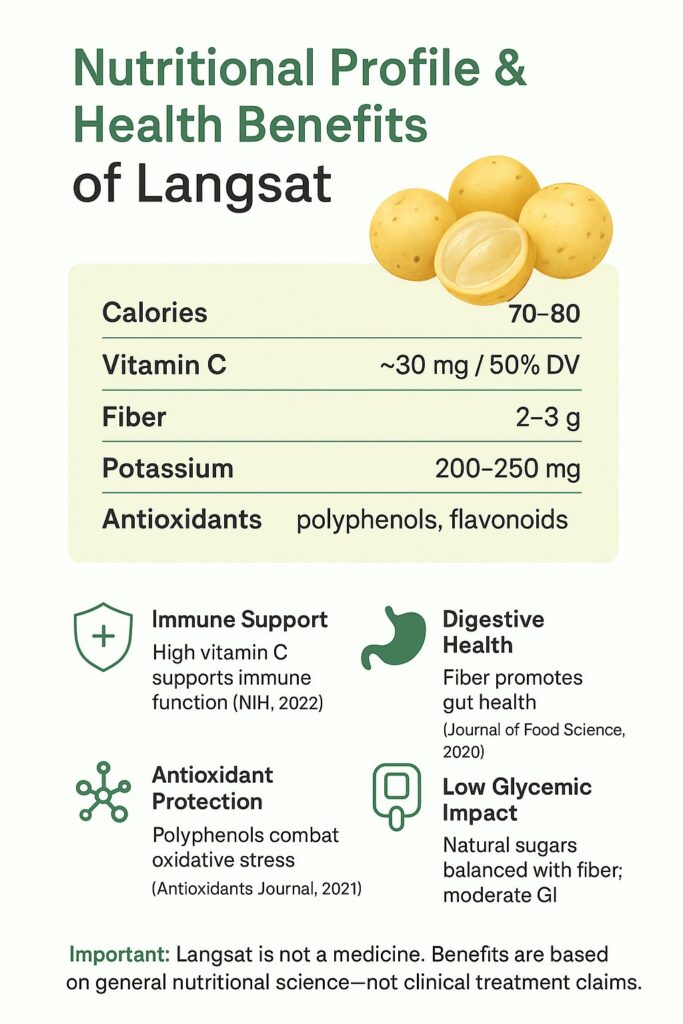
immunity and gut health — all in a naturally sweet tropical fruit.
Important: Langsat is not a medicine. Benefits are based on general nutritional science—not clinical treatment claims.
Where to Buy Langsat
How to Find Lanzones (Fresh or Canned) — Anywhere in the World
Lanzones (langsat) is highly seasonal and rarely shipped globally due to its delicate skin—but that doesn’t mean you can’t find it! Whether you’re in Manila, Miami, Melbourne, or Munich, here’s how to track it down:
In-Store (Seasonal: August–October)
- Visit Southeast Asian or Filipino grocery stores
- Many import fresh lanzones during peak harvest but don’t always display them upfront.
Pro tip: Ask the staff directly in late August: “Do you get fresh lanzones this season?”
Check international aisles in large supermarkets
- Look for canned lanzones in syrup (common year-round).
- Always check the label: it should list “lanzones,” “langsat,” or “Lansium domesticum.”
Online (Year-Round Options)
Search major online grocers:
- Amazon (search: “canned lanzones” or “langsat in syrup”)
- Weee!, Yamibuy, or FilStop (popular with Filipino diaspora communities)
- Local ethnic e-grocers in your country (e.g., Tong Garden in Singapore, Olam in Europe)
Set alerts: Use Amazon or Google Shopping alerts for “lanzones” starting in July—so you’re notified when seasonal stock arrives.
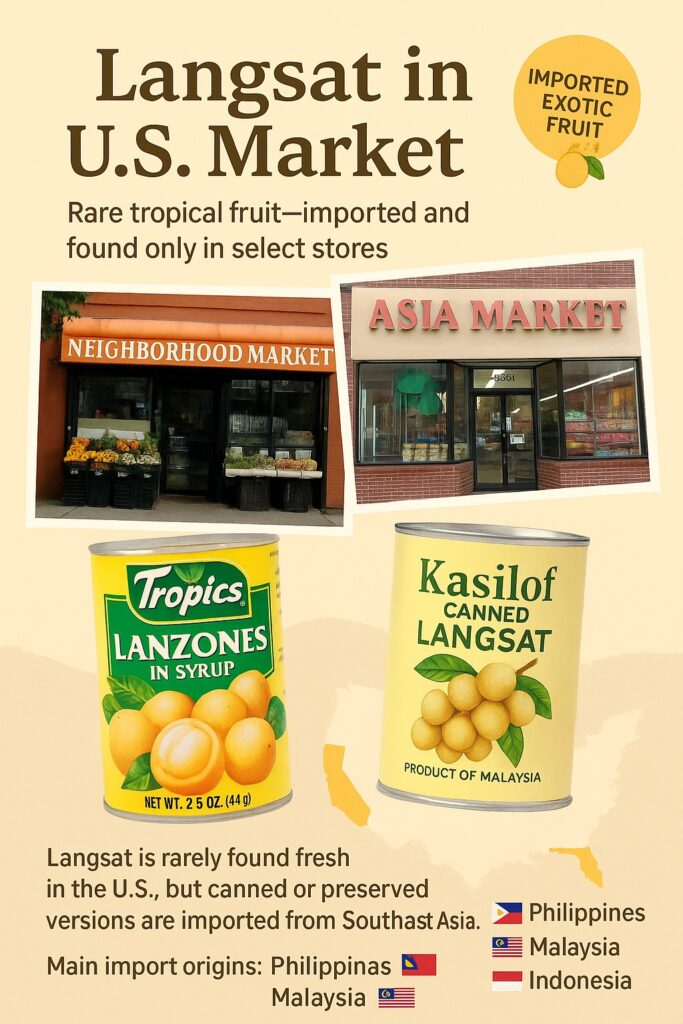
Community & Social Hacks
Search Facebook or Instagram for:
- “[Your city] Filipino market”
- “Lanzones near me” or “Fresh lanzones [your country]”
- Many small vendors post harvest updates only on social media!
Join expat or cultural groups:
Facebook groups like “Filipinos in [Your Country]” or “Southeast Asian Food Lovers” often share real-time alerts when launches arrive in local markets.
Bonus Tip: If you’re near a Filipino church, cultural center, or consulate, ask around—community networks often know about private imports or farm shares!
Langsat vs. Look-Alikes: Clearing the Confusion
Don’t confuse langsat with its tropical cousins! Here’s how to spot the difference:
Langsat (Lanzones) – Lansium domesticum
- Grows in garlic-like clusters
- Flesh is segmented (like cloves)
- Skin: thin to medium, golden-brown when ripe
Longan – Dimocarpus longan
- Single seed inside smooth, brittle brown shell
- Flesh: translucent, less juicy, mild musky flavor
- Often called “dragon eye”
Lychee – Litchi chinensis
Bright red, bumpy shell (turns brown when stored)
Flesh: floral-sweet, no segments, one large seed
Rambutan – Nephelium lappaceum
- Hairy red shell (the name means “hairy” in Malay!)
- Flesh: nearly identical to lychee—juicy and sweet
Quick Memory Trick:
- Langsat = Layered (segments)
- Lychee = Lumpy shell
- Longan = Looks like an eyeball (translucent flesh + dark seed)
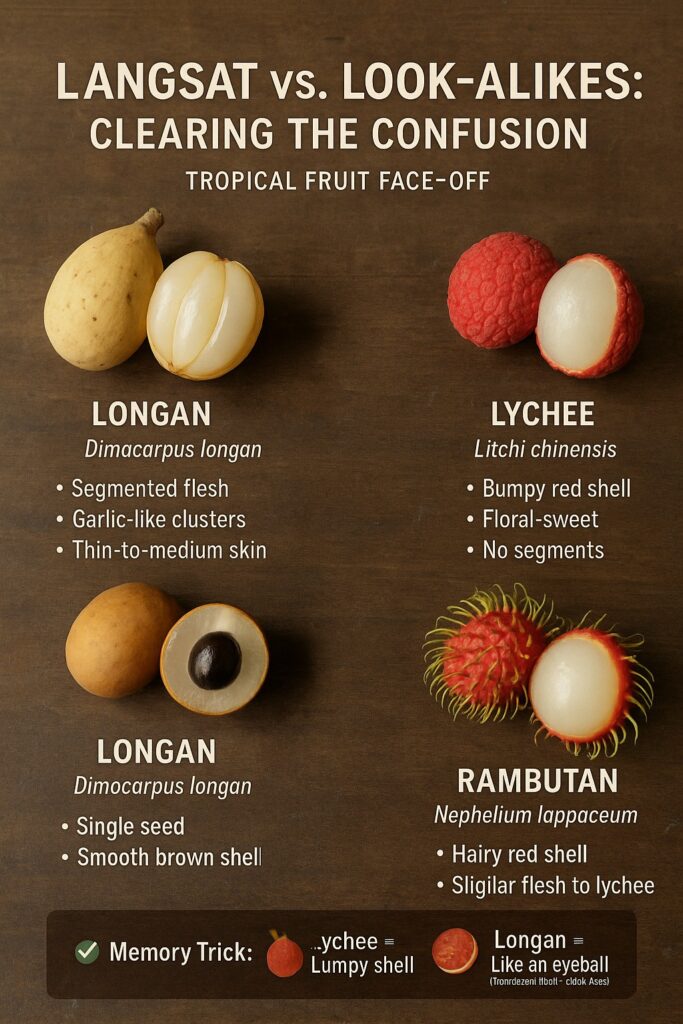
Lychee & Rambutan compare in sweetness, flavor, and origin.”
Can You Grow Langsat in the U.S.?
Langsat trees need:
- Tropical climate (no frost!)
- High humidity (>70%)
- Well-drained, slightly acidic sol
Verdict:
- Not viable in most of the U.S.
- Possible in microclimates: South Florida, Hawaii, Puerto Rico
- Saplings: Rare—but check Logee’s Plants (CT) or Tropical Fruit Nursery (FL) for availability.
Cultural Significance: Festivals & Traditions
- Philippines: The Lanzones Festival in Camiguin (October) features street dancing, fruit offerings, and farm tours.
- Malaysia: Langsat is served during Hari Raya as a symbol of sweetness and prosperity.
- Indonesia: Used in traditional jamu (herbal drinks) for digestion.
FAQs About Langsat
Is langsat the same as lanzones?
Yes—just different regional names for Lansium domesticum.
Can I eat the seeds?
No. Seeds are bitter and contain compounds best avoided.
Is langsat safe for diabetics?
In moderation. It has natural sugars but also fiber. Consult your doctor.
How do I store langsat
Keep at room temperature for 2–3 days, or refrigerate in a paper bag for up to 5 days.
Final Thoughts: A Fruit Worth Seeking
Langsat (or lanzones) is more than a seasonal treat—it’s a taste of Southeast Asian heritage, packed with flavor and nutrients. While it may be elusive in the U.S., its brief appearance each fall is worth the hunt.
And if you’re in the Philippines during harvest season? Don’t miss it. Few fruits capture the essence of tropical abundance like a cluster of fresh, sun-ripened lanzones.
Reference:
- “Lansium domesticum — A Fruit with Multi-Benefits: Traditional Uses, Phytochemicals, Nutritional Value, and Bioactivities”
- Journal: Nutrients (MDPI)
- Link: https://www.mdpi.com/2072-6643/14/17/3663
- “Determination of Free Radical Scavenging, Antioxidative DNA Damage Activities and Phytochemical Components of Active Fractions from Lansium domesticum Corr. Fruit”
- Journal: Nutrients (2015) (Open Access)
- Link: https://www.ncbi.nlm.nih.gov/pmc/articles/PMC4555151/
- “New Triterpenoids from Lansium domesticum Corr. cv kokossan and their cytotoxic properties”
- Article: Isolation of novel triterpenes from peel and seeds; Cytotoxicity tested against MCF-7 cell lines
- Link: https://www.ncbi.nlm.nih.gov/pmc/articles/PMC10004713/
- “Proximate Composition and Mineral Contents of Duku (Lansium domesticum)”
- Journal / Article reporting nutrient / mineral profiles of peel, pulp, seed
- Link: https://article.sapub.org/10.5923.j.food.20211101.02.html
- “Encapsulation of Lansium domesticum Leaves Extract: Advancing Polyphenol Stability and Antioxidant Activity”
- Journal: Egyptian Journal of Botany
- Link: https://ejbo.journals.ekb.eg/article_428852.html
- “Effects of Pretreatment and Drying Temperatures on Physicochemical and Antioxidant Properties in Dried Duku Fruit”
- Study on how drying / preprocessing affects antioxidant capacity
- Link : https://www.sciencedirect.com/science/article/pii/S2772275924000157
- “Cytotoxic activity of the purified extracts from duku (Lansium domesticum)”
- Paper looking at cytotoxicity of leaf or fruit extracts against cancer cell lines
- Link (via a PDF): https://jmpcr.samipubco.com/article_182193_daed7edc306720148316c84abdf7514c.pdf
- “A Review on Phytochemicals and Pharmacological Activities of Lansium domesticum”
- Open access review summarizing antioxidant, antibacterial, cytotoxic activities
- Link (Open Access) Macedonian Journal of Medical Sciences / OAMJMS): https://oamjms.eu/index.php/mjms/article/view/8394
